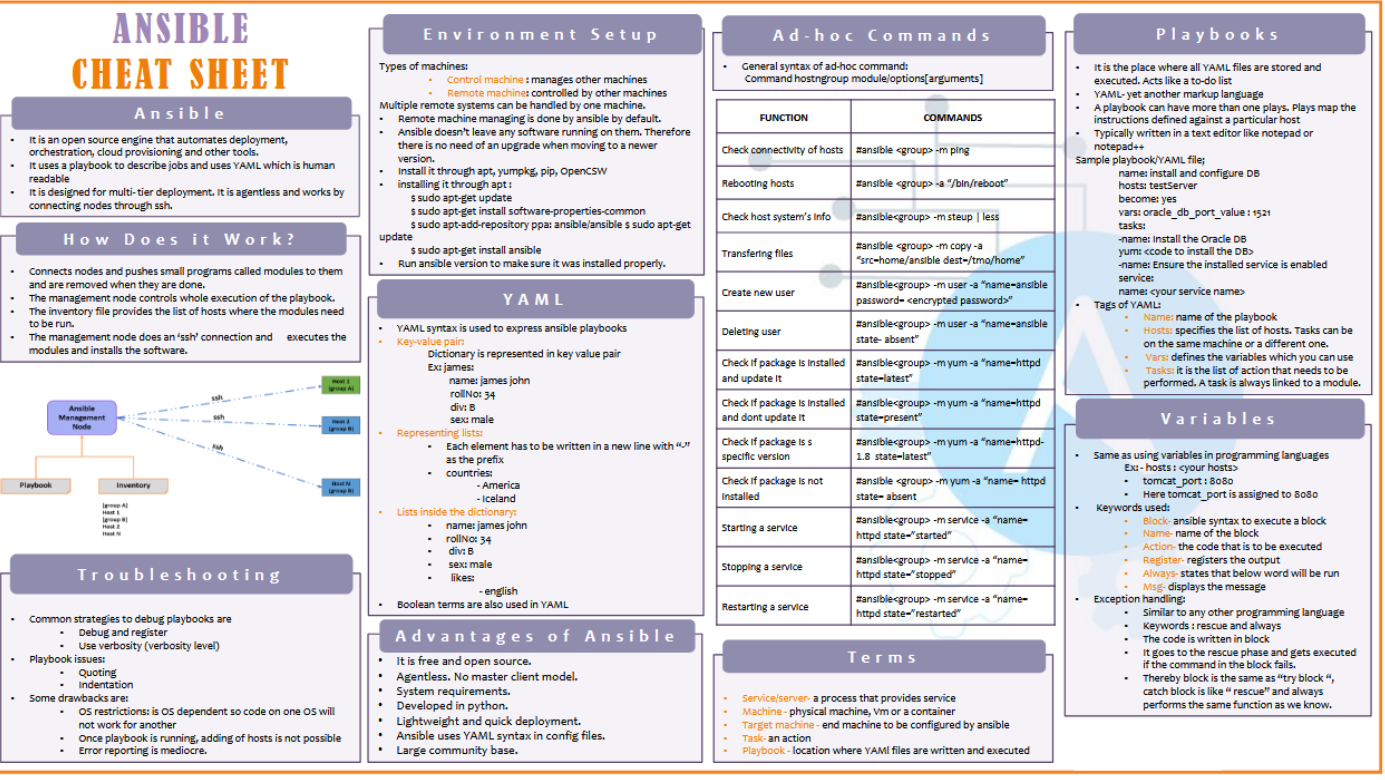What is Ansible and Business Use Case and Cheatsheet for Ansible for Beginners in Detail
Ansible is an open-source automation tool used for configuration management, application deployment, and task automation. It is designed to automate IT processes and help organizations manage complex IT environments with ease. Ansible uses a simple, human-readable language (YAML) to describe automation jobs, which makes it accessible for beginners and powerful for experts.

Key Features of Ansible:
- Agentless: No need to install any software or agent on the client systems.
- Simple YAML Syntax: Uses YAML (Yet Another Markup Language) for writing playbooks.
- Idempotency: Ensures that changes are only applied when necessary, avoiding repeated tasks.
- Extensible: Supports modules for various types of tasks (e.g., cloud provisioning, configuration management, application deployment).
Business Use Cases for Ansible:
- Configuration Management: Ensuring all servers are configured consistently.
- Example: Setting up and maintaining consistent configurations across web servers, databases, and application servers.
- Application Deployment: Automating the deployment of applications across multiple servers.
- Example: Deploying a web application to multiple environments (development, staging, production).
- Provisioning: Automating the creation of cloud instances and configuring them.
- Example: Creating and configuring AWS EC2 instances with predefined configurations.
- Continuous Integration/Continuous Deployment (CI/CD): Integrating with CI/CD pipelines to automate the build, test, and deployment processes.
- Example: Integrating with Jenkins to automate the deployment of a web application after successful testing.
- Security and Compliance: Automating security updates and compliance checks.
- Example: Ensuring that all servers have the latest security patches applied and compliance standards are met.
Ansible Cheatsheet for Beginners
Basic Concepts:
- Inventory: A list of hosts managed by Ansible, defined in an inventory file.
- Modules: Units of work in Ansible, such as tasks (e.g., installing software, copying files).
- Playbooks: YAML files that define a series of tasks to be executed on managed hosts.
- Roles: A way to group related tasks, variables, and files to organize playbooks.
Installation
Install Ansible on Ubuntu
sudo apt update
sudo apt install ansible -yInstall Ansible on CentOS/RHEL
sudo yum install epel-release -y
sudo yum install ansible -yBasic Inventory File (hosts):
[webservers]
web1.example.com
web2.example.com
[databases]
db1.example.com
db2.example.com
Ansible Configuration File (ansible.cfg):
[defaults]
inventory = hosts
remote_user = your_username
host_key_checking = False
4. Ad-Hoc Commands
- Ping all hosts:
ansible all -m pingInstall a package:
ansible all -m apt -a "name=nginx state=present" --becomeCopy a file:
ansible all -m copy -a "src=/path/to/local/file dest=/path/to/remote/file" --become- Restart a service:
ansible all -m service -a "name=nginx state=restarted" --become5. Playbook Structure
Basic Playbook Example (playbook.yml):
- name: Install and start Nginx
hosts: webservers
become: yes
tasks:
- name: Ensure Nginx is installed
apt:
name: nginx
state: present
when: ansible_os_family == "Debian"
- name: Ensure Nginx is running
service:
name: nginx
state: started
enabled: yes
Run the Playbook:
ansible-playbook playbook.yml
6. Common Modules
- Package Management:Copy code
state: present - name: Install a package using yum yum: name: package_name state: present
- name: Install a package using apt
apt:
name: package_name
state: present
- name: Install a package using yum
yum:
name: package_name
state: present
- File Management:
- name: Copy a file
copy:
src: /path/to/local/file
dest: /path/to/remote/file
- name: Manage file properties
file:
path: /path/to/remote/file
state: touch
mode: '0644'
- Service Management:
- name: Ensure a service is running
service:
name: service_name
state: started
- User Management:yaml
- name: Create a user
user:
name: username
state: present
- Template Management:
- name: Deploy a configuration file from a template
template:
src: /path/to/template.j2
dest: /path/to/remote/config
7. Variables
Defining Variables in Playbooks:
- name: Using variables
hosts: webservers
vars:
package_name: nginx
tasks:
- name: Ensure the package is installed
apt:
name: "{{ package_name }}"
state: present
when: ansible_os_family == "Debian"
Defining Variables in Inventory:
[webservers]
web1.example.com package_name=nginx
web2.example.com package_name=httpd
Using Variables in Tasks:
- name: Install package
apt:
name: "{{ package_name }}"
state: present
8. Roles
Creating a Role:
ansible-galaxy init myrole
Directory Structure of a Role:
myrole/
├── tasks
│ └── main.yml
├── handlers
│ └── main.yml
├── templates
│ └── config.j2
├── files
│ └── myfile
├── vars
│ └── main.yml
├── defaults
│ └── main.yml
└── meta
└── main.yml
Using a Role in a Playbook:
- name: Apply myrole
hosts: webservers
roles:
- myrole
Conclusion
This detailed cheatsheet provides a comprehensive guide to getting started with Ansible, from installation and configuration to using modules, variables, and roles. As you become more familiar with Ansible, you can explore more advanced features and create complex automation tasks to streamline your IT operations.
